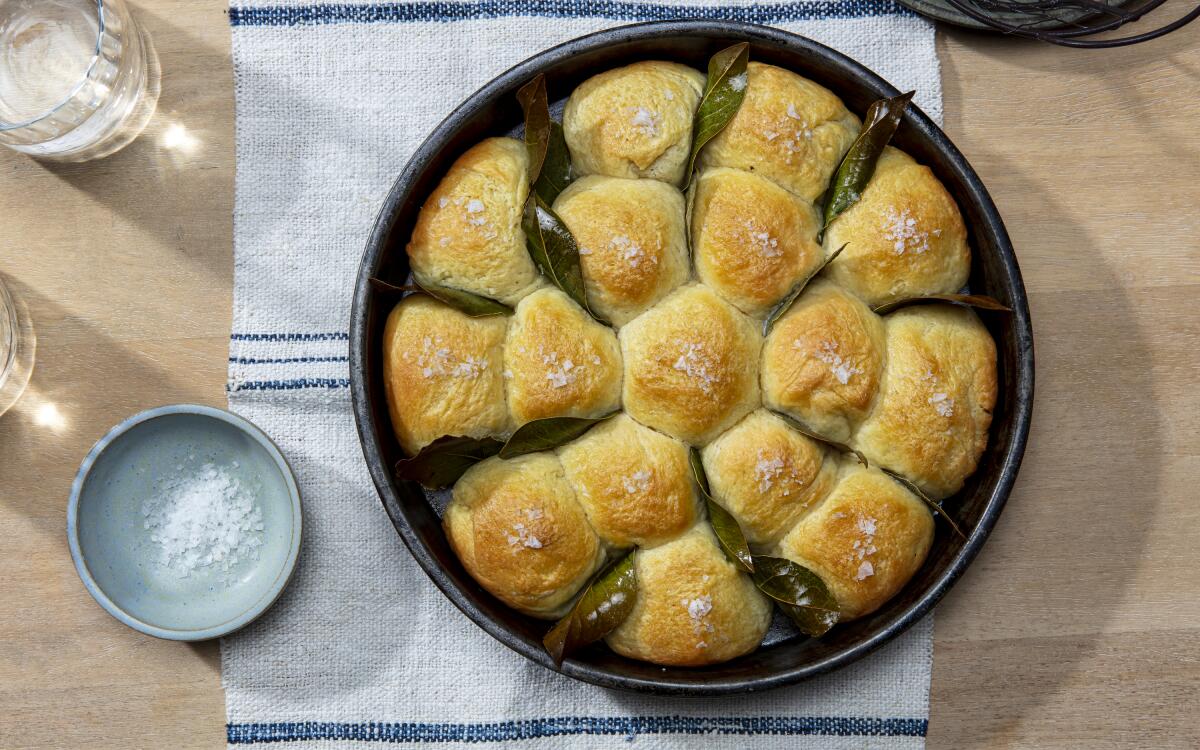Bay Leaf Butter Yeast Rolls

Instead of doing things the way they’ve always been done, here are recipes for Thanksgiving 2020 that throw tradition out the window — at least just this once — and show how the classics can be much easier, and more fun, when you focus on highlighting the qualities in each that really matter.
Before each time you use the bay leaf butter, stir it again to ensure the milk solids are evenly mixed with the fat, which will separate as the butter sits and cools. The pan in which you bake these rolls matters: Use a light metal or glass pan if possible since a dark metal pan can over-brown the bottoms of the rolls before the tops are cooked through.
Melt the butter with four of the bay leaves in a small saucepan over medium heat, and continue heating until the white foam dissipates. Remove the pan from the heat and set aside while you make the dough.
Warm the milk in a small saucepan or in a heatproof bowl in the microwave until it reaches 105 degrees on an instant-read thermometer. Pour it into the bowl of a stand mixer fitted with a dough hook (or a large bowl) and stir in the yeast and syrup; let stand until foamy, about 10 minutes. If using instant yeast, proceed with the next step without waiting.
Stir the bay leaf butter to ensure it’s well mixed, then pour ¼ cup of it into the yeast mixture (it’s OK if it’s still warm). Add the flour and mix on low speed (or stir with a wooden spoon) until a dough forms, about 1 minute. Increase the mixer speed to medium (or transfer the dough to a lightly floured work surface) and knead until smooth and the dough begins slapping the side of the bowl, 6 to 8 minutes in the mixer, about 10 minutes by hand.
With the mixer running, add the kosher salt and continue mixing for 1 minute longer (or add the salt and knead in by hand). If using a mixer, clean the dough off the dough hook and shape into a ball in the bowl. If kneading by hand, shape the dough into a ball and return to a large bowl. Cover your bowl with plastic wrap or a kitchen towel. Let sit in a draft-free area until nearly doubled in size, about 1 hour.
Stir the bay leaf butter again and use a brush to grease the bottom and side of a 9-inch round baking pan, preferably light metal, glass or ceramic, with some of it. Transfer the dough to a cutting board and cut into 16 rough wedges. Roll each wedge into a ball, then arrange in the greased pan, spaced evenly apart (preferably a circle of nine around the perimeter, six inside that and one in the center).
Fish the four bay leaves out of the butter, scraping any butter clinging to them, and brush the remaining 12 leaves with some butter. Tuck a whole bay leaf in the gap between each roll, making sure their tips are pointing up and out and the leaves are oriented so their flat sides will press against the dough once the balls rise. Cover the pan loosely with plastic wrap or a kitchen towel and let sit until the dough balls have risen and are just beginning to touch the plastic wrap or towel, about 1 hour.
Heat the oven to 375 degrees. Lightly brush the tops of the rolls with some of the remaining bay leaf butter (take care not to deflate the rolls), then bake until puffed and golden brown on their tops, 23 to 25 minutes (if you use a dark metal pan, check the rolls at 20 minutes).
Transfer the pan to a wire rack and while the rolls are still hot, brush them with the remaining bay leaf butter. Sprinkle each roll with a pinch of flaky sea salt while still wet with butter. Let rest at least 5 minutes before serving.
Get our Cooking newsletter.
Your roundup of inspiring recipes and kitchen tricks.
You may occasionally receive promotional content from the Los Angeles Times.
















